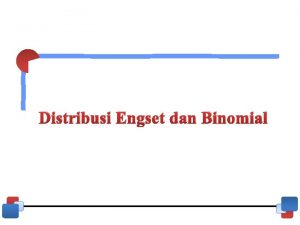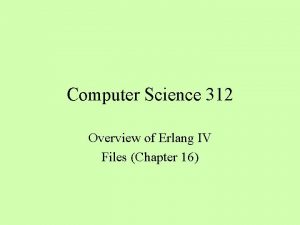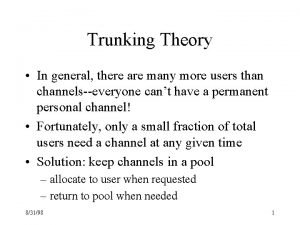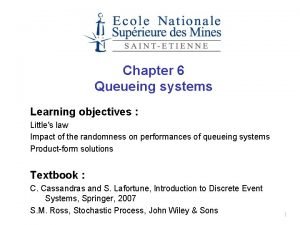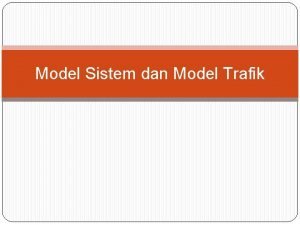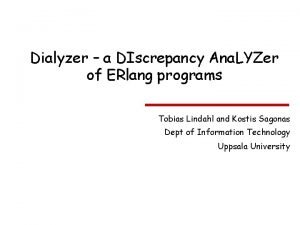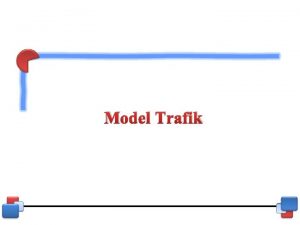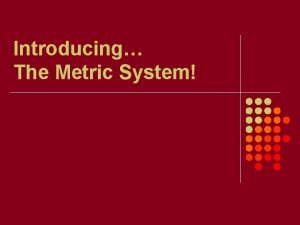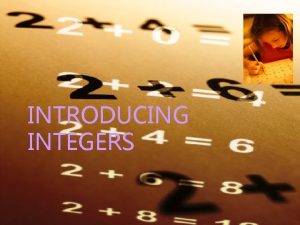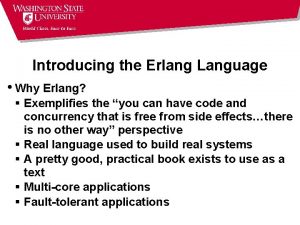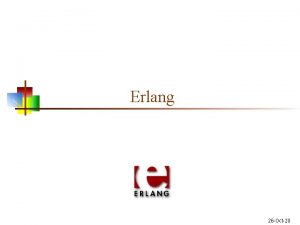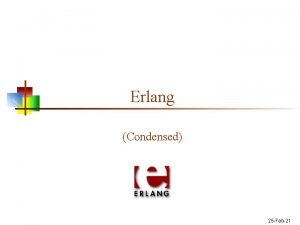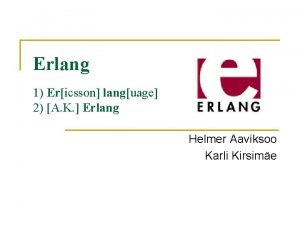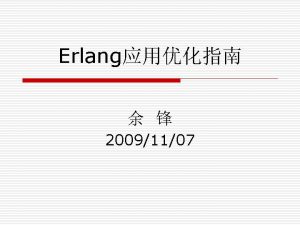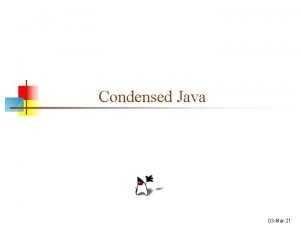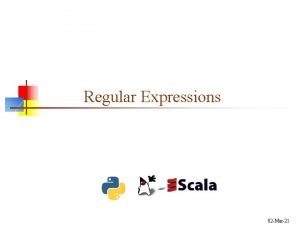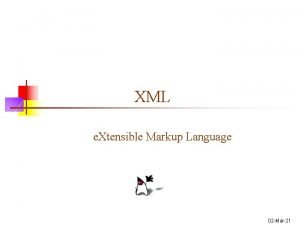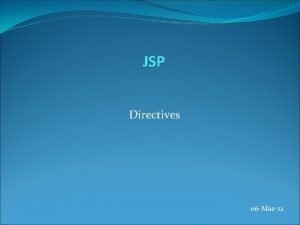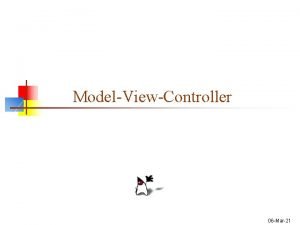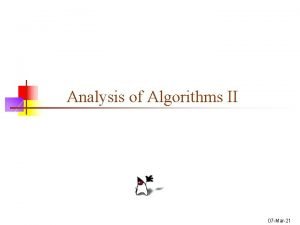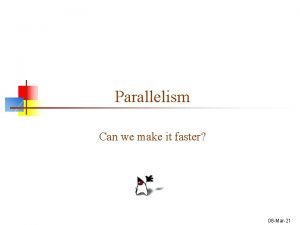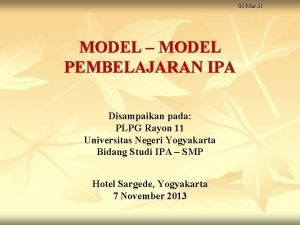Erlang 06 Mar21 Introducing Erlang n n Erlang


























- Slides: 26

Erlang 06 -Mar-21

Introducing Erlang n n “Erlang” is a contraction of “Ericsson Language, ” named for the Ericsson company that makes telephone switching equipment Erlang began as a set of extensions to Prolog Erlang was created by Dr. Joe Armstrong Erlang is a functional language which is important for two things: n n It supports extremely high concurrency It supports extreme reliability 2

Running Erlang n Double-click on the Erlang icon, or type erl into a terminal (cmd) window n n You can try short pieces of code from here, but you cannot import code or define functions Use c(module. erl). (no quote marks) to compile a module named module from the file module. erl. n n To use a function func defined in module. erl, use module: func(args) Use f(). to clear (forget) previous associations. Use the up and down arrows to choose a previous entry. Use control-C to exit the shell. 3

Directives n An Erlang program should begin with -module(filename). where filename. erl is the name of the file it is on n To use functions defined in another file, use -import(filename, [function 1/arity 1, . . . , function. N/arity. N]). n n Imported methods may be called without a filename: prefix. To provide functions defined in this file to other programs, use either of n n -export(filename, [function 1/arity 1, . . . , function. N/arity. N]). -compile(export_all).

Names n Variables begin with a capital letter or an underscore n n n The special variable _ is the “don’t care” variable Variables are either bound (have a value) or unbound; once bound, they cannot be changed Function names and atoms begin with a lowercase letter n An atom is a word that stands for itself

Data types n n n Integers, of unlimited size: 1112223344455666777888999000 Floats: 1234. 5678, 6. 0221415 e 23 Strings, enclosed in double quotes: "This is a string. " n n Atoms: atom 1, 'Atom 2' n n A string is implemented as a list of ASCII (integer) values Begin with a lowercase letter, or are enclosed in single quotes Lists: [abc, 123, "pigs in a tree"] Tuples: {abc, 123, "pigs in a tree"} Binaries: <<0, 255, 128>>, <<"hello">>, <<X: 3, Y: 7, Z: 6>> n n Binaries exactly specify bits The number of bits in a binary must be a multiple of 8.

What is the syntax for a tuple? n n (1, 2, 3) [1, 2, 3] {1, 2, 3} <<1, 2, 3>> 25 7

Operations n n Arithmetic: +X -X X * Y n n X+Y X-Y Comparison: X < Y X =: = Y X =/= Y X > Y n n X / Y X div Y X rem Y Only for comparing integers and floats: X == Y 5 == 5 and 5 == 5. 0 are true; 5 =: = 5. 0 is false. Boolean: not X X and Y Bitwise: bnot X X band Y X or Y X bor Y X andalso Y X bxor Y X /= Y X orelse Y X bsl Y X bsr Y

Which of these is not a legal operation? A. B. C. D. X X div Y <= Y orelse Y bor Y 25 9

Pattern matching n n Pattern matching looks like assignment: pattern = expression The pattern may be a constant, a bound or unbound variable, or a structure (such as a list or tuple) containing these n n Example: {ok, Stream} = file: open(File. Name, write) Although pattern matching isn’t assignment, Erlang is one of a number of so-called “single assignment” languages

Case expressions n n n case Expression of Pattern 1 when Guard 1 -> Expression_sequence 1; Pattern 2 when Guard 2 -> Expression_sequence 2; . . . Pattern. N when Guard. N -> Expression_sequence. N end The when Guard parts are optional boolean tests An expression sequence is a sequence of expressions separated by commas n n n The value of a case expression is the value of the (one) expression sequence evaluated The value of an expression sequence is the value of the last expression evaluated Semicolons must be exactly as shown: Required after every case except the last, not allowed after the last case

In case expressions, semicolons are used: A. B. C. Between cases After cases At the very end 25 12

If expressions n n n if Guard 1 -> Expression_sequence 1; Guard 2 -> Expression_sequence 2; . . . Guard. N -> Expression_sequence. N end The value of an if expression is the value of the (one) expression sequence evaluated In Erlang, every statement must have a value, or it is an error n n Frequently true is used as the last guard However, it is good style to use something more explicit than true , if you can easily do so

Guards n Guards may not have side effects n n n You cannot use a user-defined function in guards You can use type tests, boolean operators, bitwise operators, arithmetic operators, relational operators Here is the complete list of functions you can use in guards: abs(Number) hd(List) node(X) size(Tuple. Or. Binary) element(Integer, Tuple) length(List) round(Number) trunc(Number) float(Number) node() self() tl(List)

Anonymous functions n The syntax for an anonymous function is fun(Patterns 1) -> Body 1; (Patterns 2) -> Body 2; . . . (Patterns. N) -> Body. N end n n Anonymous functions are frequently used as parameters to other functions Because a function is a value, it can be assigned to a name: My. Function = fun … end.

Is the following legal? Double = fun(X) -> 2 * X. A. B. C. Yes. No, “X” isn’t a pattern No, you can’t give an anonymous function a name. 25 16

Named functions n The syntax for a named function is a series of one or more clauses: name(Patterns 1) -> Expression_sequence 1; name(Patterns 2) -> Expression_sequence 2; . . . name(Patterns. N) -> Expression_sequence. N. where n n The name and the arity are the same for each clause Clauses are tried in order until one of the parameter lists (sequence of patterns) matches, then the corresponding expression sequence is evaluated The value of the function is the value of the expression sequence that is evaluated It is an error if no parameter list matches.

List operations n The following list operations are predefined: n hd(List) -> Element n n tl(List) -> List n n Returns the list minus its first element length(List) -> Integer n n Returns the first element of the list Returns the length of the list To use other list functions, either: n n List the functions in an import directive, or Prefix each function name with lists:

More list operations n seq(From, To) -> Seq n n map(Fun, List 1) -> List 2 n n Takes a function from As to Bs, and a list of As and produces a list of Bs by applying the function to every element in the list The evaluation order is implementation dependent Example: lists: map(fun(X) -> 2 * X end, [1, 2, 3]). % Result is [2, 4, 6] filter(Pred, List 1) -> List 2 n n n Returns a sequence of integers from From to To, inclusive List 2 is a list of all elements Elem in List 1 for which Pred(Elem) returns true Example: lists: filter(fun(X) -> X =< 3 end, [3, 1, 4, 1, 6]). % Result is [3, 1, 1] foldl(Fun, Acc 0, List) -> Acc 1 n n Calls Fun(Elem, Acc. In) on successive elements A of List, starting with Acc. In == Acc 0 Fun/2 must return a new accumulator which is passed to the next call The function returns the final value of the accumulator, or. Acc 0 is returned if the list is empty Example: lists: foldl(fun(X, Y) -> X + 10 * Y end, 0, [1, 2, 3, 4, 5]). % Result is 12345

List comprehensions n A list comprension has the syntax [Expression || Generator, Guard. Or. Generator, . . . , Guard. Or. Generator] where n n n The Expression typically makes use of variables defined by a Generator A Generator provides a sequence of values; it has the form Pattern <- List A Guard is a test that determines whether the value will be used in the Expression At least one Generator is required; Guards and additional Generators are optional Example list comprehension: N = [1, 2, 3, 4, 5]. L = [10 * X + Y || X <- N, Y <- N, X < Y]. % Result is [12, 13, 14, 15, 23, 24, 25, 34, 35, 45]

What is the result of [3 * X || X <- [1, 2, 3, 4, 5], X =/= 3] ? A. B. C. D. It’s incorrect syntax [3, 6, 12, 15] [3, 6, 9, 12, 15] [9] 25 21

Input/Output n Input from the console: n Line = io: get_line(Prompt). n n Term = io: read(Prompt). n n n io: format(String. To. Print). io: format(Format. String, List. Of. Data). Input from a file: n n Reads in one Erlang term, which must be terminated with a period Output to the console: n n An atom is best used as a prompt; returns a string ending in n {ok, Stream} = file: open(File. Name, read), Line = io: get_line(Stream, ''), % May return eof file: close(Stream). Output to a file: n {ok, Stream} = file: open(File. Name, write), io: format(Stream, Format. String, List. Of. Data), file: close(Stream).

Format strings n On output, data is interpolated (inserted) into the Format. String at the following locations (excluding ~n): n n ~s Print as a string ~w Print any value in "standard syntax“ n n Strings are printed as lists of integers ~p Pretty print any value (breaking lines, indenting, etc. ) ~n Print a newline (you can also use n) Comments begin with a % and extend to the end of the line

A first example n -module(ex). -compile(export_all). factorial(1) -> 1; factorial(N) -> N * factorial(N - 1). n 3> c(ex. erl). {ok, ex} 4> ex: factorial(10). 3628800 5> ex: factorial(100). 933262154439441526816992388562667004907159682643816214685 929638952175999932299156089414639761565182862536979208272 23758251185210916864000000000000 6> 24

Useful URLs n n The Erlang reference manual: http: //www. erlang. org/doc/reference_manual/users_guide. html OTP Reference Page Index: http: //www. erlang. org/doc/man/ Learn You Some Erlang for Great Good http: //learnyousomeerlang. com/ A Concise Guide to Erlang http: //www. cis. upenn. edu/~matuszek/cis 5542010/Concise. Guides/concise-erlang. html

The End
 Engset
Engset Erlang file consult
Erlang file consult Who developed the fundamental of trunking theory? *
Who developed the fundamental of trunking theory? * Littles law
Littles law Mike williams erlang
Mike williams erlang Sunha cos
Sunha cos Erlang b
Erlang b Erlang b
Erlang b Rumus probabilitas blocking
Rumus probabilitas blocking Dialyzer erlang
Dialyzer erlang Contoh soal distribusi erlang
Contoh soal distribusi erlang Erlang b
Erlang b Eunit erlang
Eunit erlang Kfc founded
Kfc founded Sentence starters for a quote
Sentence starters for a quote Ariel introducing a
Ariel introducing a Quote signal phrases
Quote signal phrases Self introduction
Self introduction Templates for introducing quotations
Templates for introducing quotations Introducing family members in french
Introducing family members in french New market offering
New market offering Who invented the metric system
Who invented the metric system Ma
Ma An organism develops active immunity as a result of
An organism develops active immunity as a result of Example of leave taking conversation
Example of leave taking conversation Introducing the odyssey
Introducing the odyssey Integers essential questions
Integers essential questions
